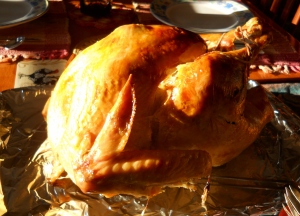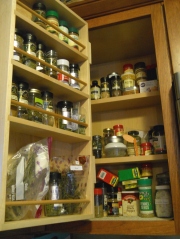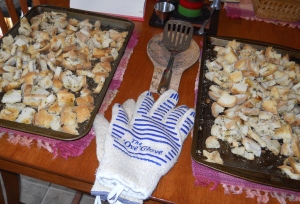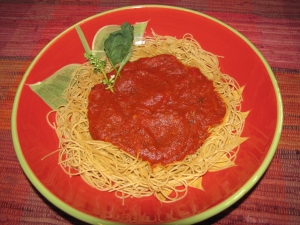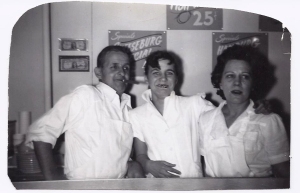On the other hand, there are so many considerations about that bird and the stuffing to go with it, before we even get to the roasting/eating part:
- How big a bird? (Definitely want leftovers. Ours was a 17+ pounder.)
- What else about the bird? (Bought a “natural, fresh” turkey this year. Generally winds up juicier.)
- To brine or not to brine? (Never tried it, wasn’t about to this time.)
- If not brining, how to ensure it’s nice and moist? (I loosened the skin and injected homemade turkey broth.)
- What about flavoring for the skin? (Basting with melted butter can’t be beat; sprinkled with pepper and a few herbs such as dried parsley, marjoram, thyme and/or rosemary.)
- What to do with all the “stuff” that’s inside? (Take the “stuff” – gizzards, heart, etc, out of the bird, put in saucepan, add water to cover, sprinkle with salt and pepper, bring to boil, then simmer until liquid is reduced by ⅓ to ½. Discard “stuff” and put aside liquid for later gravy-making.)
- How about the inside of the turkey? (Always rub with salt. Further, I considered two options: either cut a lemon in half and pull some frozen “fresh” rosemary out of the freezer, then stash it in the bird’s cavity; OR fill it with stuffing. I went with option #2.)
- How long do I cook it and at what temp? (I always look to see if it gives hourly rates on the fowl’s packaging. If not, I check one of my many cookbooks or go online. I never seem to retain this kind of info in my brain, or maybe I just worry too much about screwing it up! I do recall that 325 degrees Fahrenheit is the best temp. Still, I try to buy a bird with one of those pop-up gadgets that tells you it’s done, and then I’ll use a meat thermometer to check doneness anyway!)
- How to get it properly done without burning the skin? (I cover with aluminum foil until about the last hour in the oven. Then I remove the foil and baste a few times during next hour to ensure nice browning.)
Those are my Basics About the Bird. Not a recipe, just a guideline. Because this post is really about the stuffing. No, it’s about the prelude to the stuffing: the croutons that make up its bulk.
Prep for the stuffing began the day before Thanksgiving, with concocting homemade croutons (not all of these would go into the stuffing either—some were ground into bread crumbs for sprinkling atop potato casserole). I was determined that, this year, I would not buy a single bag of those pre-made croutons found in the supermarket. Their listing of ingredients includes whatever additives the manufacturer deems necessary to make sure the little dried-out bread bits stay dry, don’t mold, manage to last from factory to store to your house – which probably means that, even if not  deemed toxic by the government, there are still ingredients in that bag that your (or my) grandmother would not recognize as food. (Rule #2 in Michael Pollen’s Food Rules: An Eater’s Manual [Penguin Press, 2009, 2011]: “Don’t Eat Anything Your Great Grandmother Wouldn’t Recognize as Food.” I happen to be old enough that I can eliminate the “Great” since my Grandmothers were born in the late 1800s! Also note that Pollen’s Rule #3 is, “Avoid Food Products That No Ordinary Human Would Keep in the Pantry,” which means all of those ingredients on labels that I can’t pronounce, let alone remember…).
deemed toxic by the government, there are still ingredients in that bag that your (or my) grandmother would not recognize as food. (Rule #2 in Michael Pollen’s Food Rules: An Eater’s Manual [Penguin Press, 2009, 2011]: “Don’t Eat Anything Your Great Grandmother Wouldn’t Recognize as Food.” I happen to be old enough that I can eliminate the “Great” since my Grandmothers were born in the late 1800s! Also note that Pollen’s Rule #3 is, “Avoid Food Products That No Ordinary Human Would Keep in the Pantry,” which means all of those ingredients on labels that I can’t pronounce, let alone remember…).
I started with a good loaf of Italian bread from Bella Napoli Bakery and I used excellent dried spices, many of which I purchase at the Schenectady Green Market. There’s a great vendor there, March through mid-December (they head south for the winter) called Wellington’s Herbs & Spices, out of Schoharie County. In fact, I’m super-glad I made it to the Green Market today – needed more dried parsley (I use a ton of it) – because I learned that next week is their last SGM Sunday until March. This means I will do my best to get back there next weekend, after assessing my stock of dried herbs, to be sure I have an adequate supply for several months!
But I digress… back to the croutons. And a little kitchen magic.
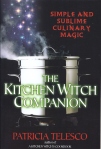 If you’ve been checking out KitchenCauldron for a while, you know I sometimes like to throw in a bit about the “magical associations” of food, which often can be connected to what science has discovered about the healing (and sometimes detrimental) properties of food. I like that one of the tenets of Patricia Telesco’s “Kitchen Witch’s Credo,” as set forth in her book The Kitchen Witch Companion: Simple and Sublime Culinary Magic (Citadel Press, Kensington Publishing Corp., 2005) reads, “There is nothing on this earth that cannot be used for magic.” She also states, “Life is a ritual and act of worship,” and “Kitchen witchery always reflects your own principles.” I believe our “principles” are developing and re-developing over our entire lifetime. A couple of decades ago I might have thought creating croutons in my own kitchen was cool but Pollen’s Rules #2 or #3 wouldn’t have come into the picture. I am older, somewhat wiser and much more worried about the fate of this planet and its inhabitants than decades ago.
If you’ve been checking out KitchenCauldron for a while, you know I sometimes like to throw in a bit about the “magical associations” of food, which often can be connected to what science has discovered about the healing (and sometimes detrimental) properties of food. I like that one of the tenets of Patricia Telesco’s “Kitchen Witch’s Credo,” as set forth in her book The Kitchen Witch Companion: Simple and Sublime Culinary Magic (Citadel Press, Kensington Publishing Corp., 2005) reads, “There is nothing on this earth that cannot be used for magic.” She also states, “Life is a ritual and act of worship,” and “Kitchen witchery always reflects your own principles.” I believe our “principles” are developing and re-developing over our entire lifetime. A couple of decades ago I might have thought creating croutons in my own kitchen was cool but Pollen’s Rules #2 or #3 wouldn’t have come into the picture. I am older, somewhat wiser and much more worried about the fate of this planet and its inhabitants than decades ago.
As one of those earth-bound occupants, I find it soothing to know that bread is associated with kinship and sustenance (think “communion”); that parsley and garlic are endowed with protective energies (and parsley might also enhance one’s luck); that coriander denotes love, well-being and intelligence; that marjoram’s magical properties are said to include peace and love. It’s interesting to me that the sage sprinkled over my croutons speaks of wisdom and  redemption, and that its thyme could aid in banishing nightmares. Cait Johnson, in Witch in the Kitchen: Magical Cooking for All Seasons (Destiny Books, 2001), writes, “Our culture considers cooking a chore; we are encouraged to get it over with as quickly as possible. But it may help us to remember that cooking was once a magical act. Cooks were priestesses who wielded the power of fire, transforming raw ingredients into nourishment for themselves and their families. The act of cooking linked women with the Goddess, the Great Nurturer.” In a fundamental way, women (and men too) are empowered through their ability to cook/bake. This is true alchemy.
redemption, and that its thyme could aid in banishing nightmares. Cait Johnson, in Witch in the Kitchen: Magical Cooking for All Seasons (Destiny Books, 2001), writes, “Our culture considers cooking a chore; we are encouraged to get it over with as quickly as possible. But it may help us to remember that cooking was once a magical act. Cooks were priestesses who wielded the power of fire, transforming raw ingredients into nourishment for themselves and their families. The act of cooking linked women with the Goddess, the Great Nurturer.” In a fundamental way, women (and men too) are empowered through their ability to cook/bake. This is true alchemy.
So think of this as a simple bit of alchemy, transforming bread into gourmet-like croutons – which can make stuffing scrumptious, enhance favorite soups and be further transmuted into tasty bread crumbs to top all sorts of dishes.
EASY-TO-MAKE, (Maybe) MAGICAL CROUTONS
Yields two large cookie sheets full of croutons (maybe 5-6 cups?)
Ingredients
- One large loaf Italian bread, sliced into cubes about ½’ to ¾” square
- 5-6 tablespoons olive oil
- 1 tablespoon dried thyme
- 1 tablespoon dried marjoram
- 1 teaspoon coriander seed
- 2 tablespoons dried parsley
- 1 tablespoon garlic granules
- ½ teaspoon dried basil
- 2 tablespoons dried sage
Process
- Pre-heat the oven to 375 degrees Fahrenheit.
- Grease two large cookie sheets with one tablespoon of olive oil each.
- Spread the bread cubes out over both sheets, trying not to overlap any.
- Combine thyme, marjoram, coriander, parsley, garlic granules, basil and sage in a bowl and mix together well
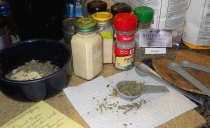
- Sprinkle the dried herb mixture over all the croutons.
- Sprinkle the remaining olive oil over the herb-sprinkled bread cubes.
- Bake in oven until turning golden-crunchy, using a spatula to turn cubes over after about 10 minutes (don’t panic if you can’t get all of them turned – it will work out just fine!). Toasting should take from 20 to 25 minutes, but start checking earlier and keep an eye on their progress. Ovens vary, temperature-wise.
- Remove from oven and allow to cool completely.
- Store in a plastic bag until using the next day in stuffing or other recipe. Or store for up to a week. (To make bread crumbs, just toss into food processor and process for a minute or two until they reach desired consistency.)
Next blog entry: the stuffing!

